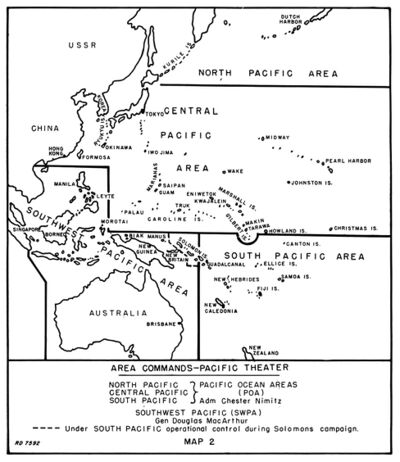Southwest Pacific Area: Difference between revisions
Jump to navigation
Jump to search

imported>Howard C. Berkowitz No edit summary |
imported>Howard C. Berkowitz No edit summary |
||
| Line 6: | Line 6: | ||
Australian forces in the theater were subordinated to the SWPA headquarters, although Australia still dealt directly with its troops in the Mediterranean. | Australian forces in the theater were subordinated to the SWPA headquarters, although Australia still dealt directly with its troops in the Mediterranean. | ||
==Command staff== | |||
*Chief of Staff, General [[Richard Sutherland]] | |||
*Intelligence director, Major General [[Charles Willoughby]] | |||
==Major components== | |||
*[[United States Seventh Fleet]] under Admiral [[Thomas Kinkaid]] | |||
*SWPA air forces under General [[George Kinney]] | |||
*[[Sixth United States Army]] commanded by General [[Walter Krueger]] | |||
*[[Eighth United States Army]] led by General [[Robert Eichelberger]] | |||
Revision as of 16:11, 22 June 2010
Under the command of General of the Army Douglas MacArthur, the Southwest Pacific Area (SWPA) was a World War II theater of operations that extended north through the Philippines and New Guinea, south through Alaska, and west to Singapore. Its eastern border included parts of the Solomons Islands.
The existence of the area, to some extent, reflected the original Japanese barrier between Hawaii and Australia, but also reflected the interservice rivalries between the U.S. Army and U.S. Navy, and the ego of MacArthur.
Australian forces in the theater were subordinated to the SWPA headquarters, although Australia still dealt directly with its troops in the Mediterranean.
Command staff
- Chief of Staff, General Richard Sutherland
- Intelligence director, Major General Charles Willoughby
Major components
- United States Seventh Fleet under Admiral Thomas Kinkaid
- SWPA air forces under General George Kinney
- Sixth United States Army commanded by General Walter Krueger
- Eighth United States Army led by General Robert Eichelberger
